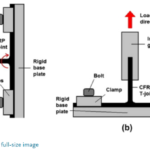Paper, Bio-inspired design of aerospace composite joints for improved damage tolerance
This paper uses a bio-inspired design strategy based on tree branch joints to improve the damage tolerance of co-cured composite T-joints. The design of tree branch joints at different length scales from the microstructural to the macro-length scale was investigated. X-ray computed tomography of a pine tree revealed three main features of tree branch joints which provide high structural efficiency and damage tolerance: integrated design with the branch embedded into the centre of the trunk; three-dimensional fibril lay-up in the principal stress directions; and variable fibril density to achieve iso-strain conditions through the joint connection. Research presented in this paper adapts the embedded structural feature of tree joints into a carbon/epoxy T-joint. The flange plies were embedded to 25%, 50% and 75% of the depth of the skin of the composite T-joint to mimic the design of tree branch joints. Experimental testing revealed that the bio-inspired T-joint design with integrated adherends had increased normalised inelastic strain energy (defined as ductility), increased normalised absorbed strain energy to failure, and higher load-carrying capacity following damage initiation (damage tolerance) compared to a conventionally bonded T-joint. However, these improvements were achieved at the expense of earlier onset of damage initiation in the T-joints.
Learn about our two Decals!
 Click here to find out more about our Fall Bioinspired Design Decal and our Spring Bioinspired Design in Action Decal – ALL MAJORS are welcome.
Click here to find out more about our Fall Bioinspired Design Decal and our Spring Bioinspired Design in Action Decal – ALL MAJORS are welcome.Berkeley BioDesign Community
 Click here to learn about the BioD: Bio-Inspired Design @ Berkeley student organization or here to signup for more info.
Click here to learn about the BioD: Bio-Inspired Design @ Berkeley student organization or here to signup for more info.Search
Student Login




I imagine that the neurological circuits underlying these processes are governed by both 2d spacing maps with their brains as…
to reduce the impact of car accidents, it may be possible to study the force diverting physics of cockroaches to…
you see this type of head-bobbing stability in many avian creatures related to pigeons like chickens. the head ability to…
not like they taught horses how to run! this is an example of convergent evolution where both sea creatures and…
The brain functions in a similar way with neuronal connections. our brains are able to utilize the multiplicity of connections…